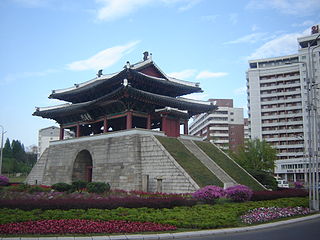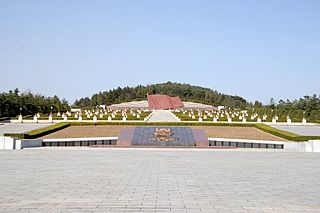
The Koryo Hotel is the second largest operating hotel in North Korea, the largest being the Yanggakdo Hotel. The Ryugyong Hotel is larger than both, but is not yet operating. The twin-towered Koryo Hotel building is 143 metres (469 ft) tall and contains 43 stories. Erected in 1985 under Kim Il Sung, it was intended to "showcase the glory and strength of the DPRK."

The Chongnyon Hotel is a hotel located in the Mangyongdae District of Pyongyang, the capital city of North Korea. It was opened on 1 May 1989 and is situated on the junction of Chongchun Street and Kwangbok (Liberation) Street.

The Korea Computer Center (KCC) is the North Korean government information technology research center. It was founded on 24 October 1990. KCC, which administered the .kp country code top-level domain until 2011, employs more than 1,000 people.

The Arch of Triumph is a triumphal arch in Pyongyang, North Korea. It was built to commemorate the Korean resistance to Japan from 1925 to 1945. It is the second tallest triumphal arch in the world, after Monumento a la Revolución in Mexico, standing 60 m (197 ft) high and 50 m (164 ft) wide.

Sunch'ŏn is a city in South Pyongan province, North Korea. It has a population of 297,317, and is home to various manufacturing plants. The city is on the Taedong River.

The Grand Mass Gymnastics and Artistic Performance Arirang, also known as the Arirang Mass Games, or the Arirang Festival is a mass gymnastics and artistic festival held in the Rungrado May Day Stadium in Pyongyang, North Korea. The games usually take place in August or September. The Arirang Mass Games were held annually between 2002 and 2013, with the exception of 2006. After a five-year hiatus, Mass Games returned for a performance entitled 'The Glorious Country' in 2018.

Moranbong or Moran Hill forms a park located in central Pyongyang, the capital of North Korea. Its 312-foot (95 m) summit is the location of the Pyongyang TV Tower.

The Foreign Languages Publishing House (FLPH) is the central North Korean publishing bureau of foreign-language documents, located in the Potonggang-guyok of Pyongyang, North Korea. It employs a small group of foreigners to revise translations of North Korean texts so as to make those texts suitable for foreign-language publication.

Potongmun is the western gate of the inner system of the walled city of Pyongyang. It was originally built in the sixth century as an official Koguryo construction, and was later rebuilt in 1473. It features a granite base topped by a two-story structure. The gate's structure was destroyed by American air attacks during the destruction of Pyongyang in Korean War, but was later reconstructed in 1955.
Sungnyong Hall is a shrine dedicated to the founding kings of ancient Korea located in the center of Pyongyang, North Korea. It is listed as National Treasure #6.

The Mangyongdae Children's Palace in Pyongyang is a public facility managed by Korean Youth Corps in North Korea where pioneer members can engage in extra-curricular activities, such as learning music, foreign languages, computing skills and sports. It was established on 2 May 1989 and it is situated in Kwangbok (Liberation) Street, in the north of Mangyongdae-guyok. It is the largest of the palaces in North Korea dedicated to children's after-school activities. In front of the Children's Palace there are a grand sculpture group and two enormous fountains, rising 90 and 100 metres.
The North Korean Championship(공화국선수권 빙상호케이 대회) is the national ice hockey championship in North Korea. It was first staged in 1956.

Taesongsan Revolutionary Martyrs' Cemetery (Korean: 대성산혁명렬사릉) is a cemetery and memorial to the North Korean soldiers fighting for freedom and independence against Japanese rule. The 30-hectares site is located near the top of Mount Taesong (Taesongsan) in the Taesong-guyŏk, just outside Pyongyang, capital of North Korea.

The Pyongyang Grand Theatre (Korean: 평양대극장) is a theatre located in North Korea. It was opened in 1960.

The Moranbong Theatre is a theatre located in Moranbong, Pyongyang, North Korea. It was opened in 1946 and renovated in 2006.

The Central Youth Hall (Korean: 청년중앙회관) is a social education center located in Pyongyang, North Korea. It opened on 18 May 1989 for the 13th World Festival of Youth and Students.

The Korean Central History Museum is a museum located in Pyongyang, North Korea. The museum is located at the north end of Kim Il-sung Square. It contains displays on Korean history from primitive society to the modern age.
The Korean Folklore Museum (조선민속박물관) is a museum in North Korea, located north of the Korean Central History Museum next to the Taedong Gate in Pyongyang. It was opened in February 1956. The museum has seven rooms comprising 1,800 square meters of space, with 2,100 exhibits.

The Pyongyang Bell (Korean: 평양종) is one of the National Treasures of North Korea.
Pyongyang International House of Culture, also known as the Pyongyang International Cultural Center, is a cultural venue in the Central District of Pyongyang, the capital of North Korea. It was opened on 2 April 1988. It serves as venue for cultural exchange with foreigners.

















